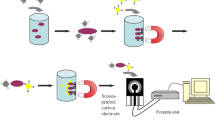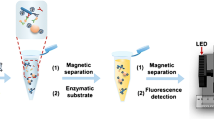Abstract
A quantitative gene detection technique targeting the pathogenic E. coli O157:H7 eaeA gene was developed using magnetic bead (MB)-quantum dots (QDs) nanoparticle complexes. MBs allowed for the separation of DNA-conjugated QD nanoparticles via magnetic field manipulation. QDs provided internal fluorescence calibration to account for the intrinsically different numbers of nanoparticles interrogated in each assay. Based on the measurement of normalized fluorescence (Cy3/QD655), the linear quantification ranges of ssDNA and dsDNA targets were determined to be 10 through 103 fM (R2 = 0.992) and 2 × 102 through 6 × 107 gene copies (R2 = 0.972), with detection limits of 9.72 fM and 104 gene copies, respectively. The kinetic results indicate that adjustment of hybridization temperature in accordance to the amount of target DNA was required to maximize the efficiency of DNA hybridization. We were able to discriminate perfectly matched target DNA, 1-, 2-, and 41-base pair mismatched target DNAs in our approach and therefore demonstrated excellent selectivity. Our technique was also used on pure bacterial culture to showcase its ability to analyze environmental samples.
Similar content being viewed by others
References
Bruchez, M., M. Moronne, P. Gin, S. Weiss, and A. P. Alivisatos (1998) Semiconductor nanocrystals as fluorescent biological labels. Science 281: 2013–2016.
Medintz, I. L., H. T. Uyeda, E. R. Goldman, and H. Mattoussi (2005) Quantum dot bioconjugates for imaging, labeling and sensing. Nat. Mater. 4: 435–446.
Pathak, S., S. K. Choi, N. Arnheim, and M. E. Thompson (2001) Hydroxylated quantum dots as luminescent probes for in situ hybridization. J. Am. Chem. Soc. 123: 4103–4104.
Gerion, D., F. Chen, B. Kannan, A. Fu, W. J. Parak, D. J. Chen, A. Majumdar, and A. P. Alivisatos (2003) Room-temperature single- nucleotide polymorphism and multiallele DNA detection using fluorescent nanocrystals and microarrays. Anal. Chem. 75: 4766–4772.
Eastman, P. S., W. Ruan, M. Doctolero, R. Nuttall, G. d. Feo, J. S. Park, J. S. F. Chu, P. Cooke, J. W. Gray, S. Li, and F. F. Chen (2006) Qdot nanobarcodes for multiplexed gene expression analysis. Nano Lett. 6: 1059–1064.
Kim, Y. S., B. C. Kim, J. H. Lee, J. Kim, and M. B. Gu (2006) Specific detection of DNA using quantum dots and magnetic beads for large volume samples. Biotechnol. Bioproc. Eng. 11: 449–454.
Son, A., D. Dosev, M. Nichkova, Z. Ma, I. M. Kennedy, K. M. Scow, and K. R. Hristova (2007) Quantitative DNA hybridization in solution using magnetic/luminescent core-shell nanoparticles. Anal. Biochem. 370: 186–194.
Son, A., M. Nichkova, D. Dosev, I. M. Kennedy, and K. R. Hristova (2008) Luminescent lanthanide nanoparticles as labels in DNA microarrays for quantification of methyl tertiary butyl ether degrading bacteria. J. Nanosci. Nanotechnol. 8: 2463–2467.
Su, X. -L. and Y. Li (2004) Quantum dot biolabeling coupled with immunomagentic separation for detection of Escherichia coli O157:H7. Anal. Chem. 76: 4806–4810.
Wu, C. -F., J. J. Valdes, W. E. Bentley, and J. W. Sekowski (2003) DNA microarray for discrimination between pathogenic O157:H7 EDL933 and non-pathogenic E. coli strains. Biosens. Bioelectron. 19: 1–8.
Sharma, V. K. and E. A. Dean-Nystrom (2003) Detection of enterohemorrhagic Escherichia coli O157:H7 by using a multiplex real-time PCR assay for genes encoding intimin and Shiga toxins. Veterinary Microbiol. 93: 247–260.
Jothikumar, N. and M. W. Griffiths (2002) Rapid detection of Escherichia coli O157:H7 with multiplex real-time PCR assays. Appl. Environ. Microbiol. 68: 3169–3171.
Ibekwe, A. M. and C. M. Grieve (2003) Detection and quantification of Escherichia coli O157:H7 in environmental samples by real-time PCR. J. Applied Microbiol. 94: 421–431.
Su, X. -L. and Y. Li (2004) A self-assembled monolayer-based piezoelectric immunosensor for rapid detection of Escherichia coli O157:H7. Biosens. Bioelectron. 19: 563–574.
Eriko Kai, K. I., S. Hoshina, H. Watanabe, and I. Karube (2000) Detection of PCR products of Escherichia coli O157:H7 in human stool samples using surface plasmon resonance (SPR). FEMS Immunol. Medical Microbiol. 29: 283–288.
Oh, B. -K., W. Lee, W. H. Lee, and J. -W. Choi (2003) Nanoscale probe fabrication using self-assembly technique and application to detection of Escherichia coli O157:H7. Biotechnol. Bioproc. Eng. 8: 227–232.
Yang, L., Y. Li, and G. F. Erf (2004) Interdigitated array microelectrode-based electrochemical impedance immunosensor for detection of Escherichia coli O157:H7. Anal. Chem. 76: 1107–1113.
Radke, S. M. and E. C. Alocilja (2005) A high density microelectrode array biosensor for detection of E. coli O157:H7. Biosens. Bioelectron. 20: 1662–1667.
Lazcka, O., F. J. D. Campo, and F. X. Munoz (2007) Pathogen detection: A perspective of traditional methods and biosensors. Biosens. Bioelectron. 22: 1205–1217.
Mao, X., L. Yang, X. -L. Su, and Y. Li (2006) A nanoparticle amplification based quartz crystal microbalance DNA sensor for detection of Escherichia coli O157:H7. Biosens. Bioelectron. 21: 1178–1185.
Call, D. R., F. J. Brockman, and D. P. Chandler (2001) Detecting and genotyping Escherichia coli O157:H7 using multiplexed PCR and nucleic acid microarrays. Int. J. Food Microbiol. 67: 71–80.
Chizhikov, V., A. Rasooly, K. Chumakov, and D. D. Levy (2001) Microarray analysis of microbial virulence factors. Appl. Environ. Microbiol. 67: 3258–3263.
Liu-Stratton, Y., S. Roy, and C. K. Sen (2004) DNA microarray technology in nutraceutical and food safety. Toxicol. Lett. 150: 29–42.
Yoo, S. M., K. C. Keum, S. Y. Yoo, J. Y. Choi, K. H. Chang, N. C. Yoo, W. M. Yoo, J. M. Kim, D. Lee, and S. Y. Lee (2004) Development of DNA microarray for pathogen detection. Biotechnol. Bioproc. Eng. 9: 93–99.
Wolf, S. F., L. Haines, J. Fisch, J. N. Kremsky, J. P. Dougherty, and K. Jacobs (1987) Rapid hybridization kinetics of DNA attached to submicron latex particles. Nucleic Acids Res. 15: 2911–2926.
Wang, H., J. Wang, C. Timchalk, and Y. Lin (2008) Magnetic electrochemical immunoassays with quantum dot labels for detection of phosphorylated acetylcholinesterase in plasma. Anal. Chem. 80: 8477–8484.
Ripp, J. (1996) Analytical Detection Limit Guidance. Wisconsin Department of Natural Resources (ed.), PUBL-TS-056-96, Wisconsin.
Kim, Y. H., G. Y. Kim, and H. B. Lim (2010) Micro pre-concentration and separation of metal ions using microchip column packed with magnetic particles immobilized by aminobenzyl ethylenediaminetetraacetic acid. Bull. Kor. Chem. Soc. 31: 905–909.
Wu, Z. -S., J. -H. Jiang, L. Fu, G. -L. Shen, and R. -Q. Yu (2006) Optical detection of DNA hybridization based on fluorescence quenching of tagged oligonucleotide probes by gold nanoparticles. Anal. Biochem. 353: 22–29.
Dai, Q., X. Liu, J. Coutts, L. Austin, and Q. Huo (2008) A onestep highly sensitive method for DNA detection using dynamic light scattering. J. Am. Chem. Soc. 130: 8138–8139.
Ferguson, J. A., F. J. Steemers, and D. R. Walt (2000) High-density fiber-optic DNA random microsphere array. Anal. Chem. 72: 5618–5624.
Kwakye, S. and A. Baeumner (2003) A microfluidic biosensor based on nucleic acid sequence recognition. Anal. Bioanal. Chem. 376: 1062–1068.
Zhang, J., H. Qi, Y. Li, J. Yang, Q. Gao, and C. Zhang (2008) Electrogenerated chemiluminescence DNA biosensor based on hairpin DNA probe labeled with ruthenium complex. Anal. Chem. 80: 2888–2894.
Chunlai, C., W. Wang, J. Ge, and X. S. Zhao (2009) Kinetics and thermodynamics of DNA hybridization on gold nanoparticles. Nucleic Acids Res. 37: 3756–3765.
Larry, E. M. and L. M. Stols (1993) Sensitive fluorescence-based thermodynamic and kinetic measurements of DNA hybridization in solution. Biochem. 32: 3095–3104.
James, G. W. and N. Davidson (1968) Kinetics of renaturation of DNA. J. Mol. Biol. 31: 349–370.
Torsvik, V., O. Lise, and T. F. Thingstad (2002) Prokaryotic diversity-magnitude, dynamics, and controlling factors. Science 296: 1064–1066.
Ian, M. C. and P. R. Hirsch (2008) Survival of bacterial DNA and culturable bacteria in archived soils from the Rothamsted Broadbalk experiment. Soil Biol. Biochemi. 40: 1090–1102.
Author information
Authors and Affiliations
Corresponding author
Rights and permissions
About this article
Cite this article
Kim, GY., Son, A. Quantitative detection of E. coli O157:H7 eaeA gene using quantum dots and magnetic particles. Biotechnol Bioproc E 15, 1084–1093 (2010). https://doi.org/10.1007/s12257-010-0032-0
Received:
Revised:
Accepted:
Published:
Issue Date:
DOI: https://doi.org/10.1007/s12257-010-0032-0




